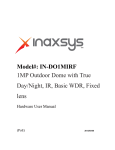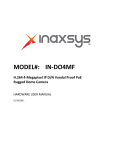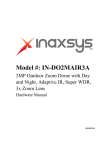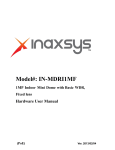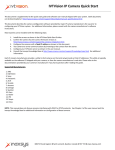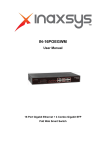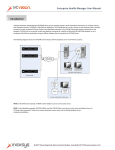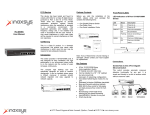Download Flat Surfaced Ceiling Mounted Exterior Dome Quick
Transcript
Outdoor Dome Flat Surfaced Ceiling Mounted Exterior Dome (Face Down) Installation Guide For Models: IN-DO2MIRVSLL, IN-DO4MF, IN-DO4M36A, IN-DO1MIRF, IN-DO2MIRF, IN-DO3MIRF, IN-DO5MIRF, IN-DO1MIRV, IN-DO2MIRV, IN-DO3MIRV & IN-DO5MIRV Installation Guide Table of Contents Installation Procedures ..................................................... 3 Step 1: Drill the Holes ................................................................................ 3 Step 2: Open the Dome Cover .................................................................. 4 Step 3: Prepare for Waterproof Installation ............................................. 5 Waterproof Solution with Naked Cable ................................................... 6 Waterproof Solution with Conduit ............................................................ 8 Step 4: Install the Camera to the Ceiling ............................................... 12 Step 5: Connect the Cable(s) .................................................................. 13 Step 6: Access the Camera Live View .................................................... 14 Step 7: Adjust the Viewing Angle and Focus ........................................ 14 Step 8: Close the Dome Cover................................................................ 15 Appendices ....................................................................... 16 Accessing the Camera Live View ........................................................... 16 Focus and Viewing Angle Adjustments ................................................. 24 Safety Information ............................................................ 30 8272 Pascal Gagnon Saint-Leonard, Quebec, Canada H1P 1Y4 www.inaxsys.com Installation Guide Installation Procedures Step 1: Drill the Holes 1. Using the supplied drill template, mark the screw holes location on the ceiling, then drill the holes and insert the plastic plugs. 2. Determine how the cables will be routed: pass through the ceiling or along the ceiling. If the cables will pass through the ceiling: a. Mark and drill the conduit hole location on the ceiling as shown on the drill template. b. Remove the metal cap covering the bottom conduit hole of the camera, and attach the cap to the side conduit hole to close it. Route the network cable to pass this hole from the ceiling. If the cables will be routed along the ceiling, skip to the next step. 8272 Pascal Gagnon Saint-Leonard, Quebec, Canada H1P 1Y4 www.inaxsys.com Installation Guide Step 2: Open the Dome Cover 1. Remove the plastic covering the camera. 2. Loosen the three (3) screws securing the dome cover. 3. Carefully lift to open the dome cover and place it on the side of the camera. NOTE: Do not abruptly lift the dome cover; it is attached to the camera with a spring wire. 8272 Pascal Gagnon Saint-Leonard, Quebec, Canada H1P 1Y4 www.inaxsys.com Installation Guide Step 3: Prepare for Waterproof Installation The camera comes with two (2) glands used for waterproof installation: Cable Gland: For use with an Exterior-grade Ethernet cable. Exterior-grade Ethernet cables are already waterproof. Waterproof Solution with Naked Cable on page 6. Conduit Gland: For use with a flexible conduit. This solution is recommended when an exterior-grade Ethernet cable is not available or when other input/output devices or external power adapter will be connected to the camera (select models only). See Waterproof Solution with Conduit on page 8. Determine the type of waterproof solution that is applicable to your installation requirements and prepare the necessary accessories or purchase extra materials. Cable Gland For use with an Exterior-grade Ethernet Conduit Gland For use with a 3/8” flexible conduit (not included in the package). cable (not included in the package). or For use with 1/2” flexible conduit (not included in the package) NOTE: The bundled conduit gland may vary. Check the conduit gland that came with your package to determine if 3/8” or 1/2" is the suitable flexible conduit size. 8272 Pascal Gagnon Saint-Leonard, Quebec, Canada H1P 1Y4 www.inaxsys.com Installation Guide Waterproof Solution with Naked Cable This section describes the procedures in using the bundled cable gland and an exterior-grade Ethernet cable. 1. Disassemble the cable gland as shown below: Body (with Washer) Sealing Insert with Claw Clamping Nut 2. Insert the clamping nut into the Ethernet cable. 3. Insert the sealing insert with claw. 8272 Pascal Gagnon Saint-Leonard, Quebec, Canada H1P 1Y4 www.inaxsys.com Installation Guide 4. Attach the cable gland body to the hole of the camera. or Attach to Camera Side Hole Attach to Camera Bottom Hole 5. If the cable will be routed along the surface, skip this step. If the cable will pass through the surface, do the following: a. Pull the network cable through the bottom conduit hole. b. Insert the sealing insert with claw into the cable gland body and then attach the clamping nut to complete the cable solution. NOTE: Make sure the clamping nut is tightly attached to the cable gland body and the sealing insert is squeezed tightly. 6. Proceed with Step 4: Install the Camera to the Ceiling on page 12. 8272 Pascal Gagnon Saint-Leonard, Quebec, Canada H1P 1Y4 www.inaxsys.com Installation Guide Waterproof Solution with Conduit This section describes the procedures to waterproof the cabling connections using the bundled conduit gland and flexible conduit. This is the recommended when an exterior-grade Ethernet cable is not available or if other input/output devices or an external power adapter will be connected to the camera (select models only). 1. Prepare the following materials for waterproof installation: Conduit Gland (included in the camera package) or For use with 3/8” flexible conduit For use with 1/2” flexible conduit Flexible Conduit 3/8” or 1/2" Trade size Network Cable CAT 5 or CAT 6 (not included in the package) (not included in the package) NOTE: The bundled conduit gland may vary. Check the conduit gland that came with your package to determine if 3/8” or 1/2" is the suitable flexible conduit size. 2. Disassemble the bundled conduit gland as shown below: 8272 Pascal Gagnon Saint-Leonard, Quebec, Canada H1P 1Y4 www.inaxsys.com Installation Guide Lock Nut Sealing Insert Body Clamping Nut NOTE: In this installation, the conduit gland body can be securely attached to the camera; therefore the use of lock nut is not necessary. Please set the lock nut aside. 3. Pull the network cable through the flex conduit. NOTE: For camera models that support external power adaptor, audio in/out, or digital input/output (DI/DO) functions, route the cables without connectors through the flex conduit together with the network cable. The connectors will be attached later after the cables pass through the conduit hole of the camera. 4. Insert the clamping nut through the flex conduit. 8272 Pascal Gagnon Saint-Leonard, Quebec, Canada H1P 1Y4 www.inaxsys.com Installation Guide 5. Insert the sealing inside and attach it at the end of the flex conduit. 6. Screw the conduit gland body to the conduit hole of the camera. or Attach to Side Conduit Hole Attach to Bottom Conduit Hole 7. If the cable will be routed along the ceiling, skip to step 8. If the cable will pass through the ceiling, do the following: a. Pull the network cable and other cables (if any) through the bottom conduit hole. 8272 Pascal Gagnon Saint-Leonard, Quebec, Canada H1P 1Y4 www.inaxsys.com Installation Guide b. Insert the sealing nut into the conduit gland body and then attach the clamping nut to complete the cable solution. 8272 Pascal Gagnon Saint-Leonard, Quebec, Canada H1P 1Y4 www.inaxsys.com Installation Guide Step 4: Install the Camera to the Ceiling 1. If necessary, insert a memory card (not supplied) into the card slot of the camera. 2. Align the camera screw holes and the conduit hole (if necessary) to the holes on the ceiling and attach the three (3) supplied screws to secure the camera. CAUTION: When using electric screwdrivers, be careful not to touch the internal camera components while attaching the screws. Since electric screwdrivers vary in sizes, speed, and force, they may bruise and damage the internal camera components. DISCLAIMER: Inaxsys Security Systems Inc. will not be responsible for camera damage caused by improper installations or the misuse of equipment for installation. 8272 Pascal Gagnon Saint-Leonard, Quebec, Canada H1P 1Y4 www.inaxsys.com Installation Guide Step 5: Connect the Cable(s) 1. If the cable will be routed along the ceiling, pull the network cable through the side conduit hole and attach the clamping nut to the conduit gland body. If the cable passes through the ceiling, skip to step 2. or Using Flex Conduit Using Naked Cable NOTE: For camera models that support external power adaptor, audio in/out, or digital input/output (DI/DO) functions, route the cables without connectors through the flex conduit together with the network cable. Once cables pass through the conduit hole of the camera, attach the bundled connectors. For more information on connecting these cables, please refer to the camera model hardware manual downloadable from the website (www.inaxsys.com). 8272 Pascal Gagnon Saint-Leonard, Quebec, Canada H1P 1Y4 www.inaxsys.com Installation Guide 2. Connect the network cable to the Ethernet port of the camera. NOTE: For models with other connectors (e.g. power adaptor, DI/DO, etc.), connect the cables to their corresponding connectors. Sample image below. Digital Input / Output (DI/DO) Connector 12V Power Connector Audio Input / Output Connector For more information on connecting these cables, please refer to the camera model hardware manual downloadable from the website (www.inaxsys.com). Step 6: Access the Camera Live View See Accessing the Camera Live View on page 16 for more information. Step 7: Adjust the Viewing Angle and Focus Based on the Live View, adjust the viewing angle and orientation of the camera. Adjustments vary per model, for detailed information, please refer to the following sections: For IN-DO1MIRF, IN-DO2MIRF, IN-DO3MIRF & IN-DO5MIRF camera models, see page 24. For IN-DO2MIRVSLL, IN-DO1MIRV, IN-DO2MIRV, IN-DO3MIRV & IN-DO5MIRV camera models, see page 25. 8272 Pascal Gagnon Saint-Leonard, Quebec, Canada H1P 1Y4 www.inaxsys.com Installation Guide For IN-DO4MF camera models, see page 26 For IN-DO4M36A camera models, see page 27. Step 8: Close the Dome Cover 1. Align the position of the dome cover shroud to the direction of the lens. 2. Tighten the three (3) screws to attach the dome cover to the camera body. 8272 Pascal Gagnon Saint-Leonard, Quebec, Canada H1P 1Y4 www.inaxsys.com Installation Guide Appendices Accessing the Camera Live View Connect the Equipment To be able to connect to the camera firmware from your PC, both the camera and the PC have to be connected to each other via Ethernet cable. At the same time, the camera has to have its own power supply. In case of PoE cameras, you can use a PoE Injector or a PoE Switch between the camera and the PC. The cameras that have the DC power connectors may be powered on by using a power adaptor. The Ethernet port LED or Power LED of the camera will indicate that the power supply for the camera works normally. Configure the IP Addresses In order to be able to communicate with the camera from your PC, both the camera and the PC have to be within the same network segment. In most cases, it means that they both should have very similar IP addresses, where only the last number of the IP address is different from each other. There are 2 different approaches to IP Address management in Local Area Networks – by DHCP Server or Manually. Using DHCP server to assign IP addresses: If you have connected the computer and the camera into the network that has a DHCP server running, then you do not need to configure the IP addresses at all – both the camera and the PC would request a unique IP address from DHCP server automatically. In such case, the camera will immediately be ready for the access from the PC. The user, however, might not know the IP address of the camera yet. It is necessary to know the IP address of the camera in other to be able to access it by using a Web browser. 8272 Pascal Gagnon Saint-Leonard, Quebec, Canada H1P 1Y4 www.inaxsys.com Installation Guide The quickest way to discover the cameras in the network is to use the simplest network search, built in the Windows system – just by pressing the “Network” icon, all the cameras of the local area network will be discovered by Windows thanks to the UPnP function support of our cameras. In the example below, we successfully found the camera model that we had just connected to the network. By double-clicking the mouse button on the camera model it is possible to automatically launch the default browser of the PC with the IP address of the target camera filled in the address bar of the browser already. 8272 Pascal Gagnon Saint-Leonard, Quebec, Canada H1P 1Y4 www.inaxsys.com Installation Guide If you work with our cameras regularly, then there is even a better way to discover the cameras in the network – by using IP Utility. The IP Utility is a light software tool that can not only discover the cameras, but also list lots of valuable information, such as IP and MAC addresses, serial numbers, firmware versions, etc, and allows quick configuration of multiple devices at the same time. The IP Utility can be downloaded for free from: http://www.inaxsys.com/en/support/downloads/software-downloads.html With just one click, you can launch the IP Utility and there will be an instant report as follows: You can quickly notice the camera model in the list. Click on the IP address to automatically launch the default browser of the PC with the IP address of the target camera filled in the address bar of the browser already. 8272 Pascal Gagnon Saint-Leonard, Quebec, Canada H1P 1Y4 www.inaxsys.com Installation Guide Use the default IP address of a camera: If there is no DHCP server in the given network, the user may have to assign the IP addresses to both PC and camera manually to make sure they are in the same network segment. When the camera is plugged into network and it does not detect any DHCP services, it will automatically assign itself a default IP: 192.168.0.100 Whereas the default port number would be 80. In order to access that camera, the IP address of the PC has to be configured to match the network segment of the camera. Manually adjust the IP address of the PC: In the following example, based on Windows 7, we will configure the IP address to 192.168.0.99 and set Subnet Mask to 255.255.255.0 by using the steps below: 1 2 4 3 8272 Pascal Gagnon Saint-Leonard, Quebec, Canada H1P 1Y4 www.inaxsys.com Installation Guide Manually adjust the IP addresses of multiple cameras: If there are more than 1 camera to be used in the same local area network and there is no DHCP server to assign unique IP addresses to each of them, all of the cameras would then have the initial IP address of 192.168.0.100, which is not a proper situation for network devices – all the IP addresses have to be different from each other. The easiest way to assign cameras the IP addresses is by using IP Utility: With the procedure shown above, all the cameras will have unique IP addresses, starting from 192.168.0.101. In case there are 20 cameras selected, the last one of the cameras would have the IP 192.168.0.120. Later, by pressing the “Refresh” button of the IP Utility, you will be able to see the list of cameras with their new IP addresses. Please note that it is also possible to change the IP addresses manually by using the Web browser. In such case, please plug in only one camera at a time, and change its IP address by using the Web browser before plugging in the next one. This way, the Web browser will not be confused about two devices having the same IP address at the same time. 8272 Pascal Gagnon Saint-Leonard, Quebec, Canada H1P 1Y4 www.inaxsys.com Installation Guide Access the Camera Now that the camera and the PC are both having their unique IP addresses and are under the same network segment, it is possible to use the Web browser of the PC to access the camera. You can use any of the browsers to access the camera, however, the full functionality is provided only for Microsoft Internet Explorer. The browser functionality comparison: Functionality Internet Explorer Other browsers Live Video Yes Yes* Live Video Area Resizable Yes No PTZ Control Yes Yes Capture the snapshot Yes Yes Yes No Yes Yes Video overlay based configuration (Motion Detection regions, Privacy Mask regions) All the other configurations * When using non-Internet Explorer browsers, free third-party software plug-ins must be installed to the PC first to be able to get the live video feed from the camera. Check the firmware version of the camera to determine which plug-in is necessary: Firmware Version Required Plug-In A1D-500-V6.04.xx-AC or older Basic VLC Media Player (http://www.videolan.org) A1D-500-V6.05.xx-AC or newer QuickTime (http://www.apple.com/quicktime/download/) The camera firmware version can be found on the FW Version column of the IP utility or access the Setup page of the Web Configurator (see page 23). Disclaimer Notice: The camera manufacturer does not guarantee the compatibility of its cameras with VLC player or QuickTime – since these are third party softwares. The third parties have the right to modify their utility any time which might affect the compatibility. In such cases, please use Internet Explorer browser instead. When using Internet Explorer browser, the ActiveX control for video stream management will be downloaded from the camera directly – the user just has to accept the use of such control when 8272 Pascal Gagnon Saint-Leonard, Quebec, Canada H1P 1Y4 www.inaxsys.com Installation Guide prompted so. No other third party utilities are required to be installed in such case. The following examples in this manual are based on Internet Explorer browser in order to cover all functions of the camera. Assuming that the camera’s IP address is 192.168.0.100, you can access it by opening the Web browser and typing the following address into Web browser’s address bar: http://192.168.0.100 Upon successful connection to the camera, the user interface called Web Configurator would appear together with the login page. The HTTP port number was not added behind the IP address since the default HTTP port of the camera is 80, which can be omitted from the address for convenience. Before logging in, you need to know the factory default Account and Password of the camera. Account: admin Password: 123456 8272 Pascal Gagnon Saint-Leonard, Quebec, Canada H1P 1Y4 www.inaxsys.com Installation Guide To check the firmware version through the Web Configurator, access the Setup page and click System > System Info. 1 2 3 For further operations, please refer to the Firmware User Manual downloadable from the website (www.inaxsys.com). 8272 Pascal Gagnon Saint-Leonard, Quebec, Canada H1P 1Y4 www.inaxsys.com Installation Guide Focus and Viewing Angle Adjustments This section describes the procedures in adjusting the viewing angle, focus, and pan direction of the different camera models under the 4” Outdoor Dome series. IN-DO1MIRF, IN-DO2MIRF, IN-DO3MIRF, IN-DO5MIRF Camera Parts Overview Adjustment Procedures 3 2 1 8272 Pascal Gagnon Saint-Leonard, Quebec, Canada H1P 1Y4 www.inaxsys.com Installation Guide 1. Loosen the tilt adjustment screws, adjust the tilt, and then tighten back the screws to fix the tilt position. 2. Move the rotation adjustment to rotate the viewing orientation. 3. Loosen the pan adjustment screw, move the pan direction, and then tighten back the screw to fix the pan position. 4. Attach the bundled lens focus tuner unto the lens and turn left or right to adjust the focus. IN-DO2MIRVSLL, IN-DO1MIRV, IN-DO2MIRV, IN-DO3MIRV, IN-DO5MIRV Camera Parts Overview 8272 Pascal Gagnon Saint-Leonard, Quebec, Canada H1P 1Y4 www.inaxsys.com Installation Guide Adjustment Procedures 3 2 4 1 1. Loosen the tilt adjustment screws, adjust the tilt, and then tighten back the screws to fix the tilt position. 2. Move the rotation adjustment to rotate the viewing orientation. 3. Loosen the pan adjustment screw, move the pan direction, and then tighten back the screw to fix the pan position. 4. Move the zoom and focus levers left or right to adjust the focus and the viewing angle. IN-DO4MF Camera Parts Overview 8272 Pascal Gagnon Saint-Leonard, Quebec, Canada H1P 1Y4 www.inaxsys.com Installation Guide Adjustment Procedures 3 2 4 1 1. Loosen the tilt adjustment screws, adjust the tilt, and then tighten back the screws to fix the tilt position. 2. Move the rotation adjustment to rotate the viewing orientation. 3. Loosen the pan adjustment screw and move the pan direction. 4. Loosen the focus adjustment screw, and move the lens left or right to adjust focus, and then tighten back the screw to fix the lens position. IN-DO4M36A Camera Parts Overview 8272 Pascal Gagnon Saint-Leonard, Quebec, Canada H1P 1Y4 www.inaxsys.com Installation Guide Adjustment Procedures 2 3 1 1. Loosen the tilt adjustment screws, adjust the tilt, and then tighten back the screws to fix the tilt position. 2. Move the rotation adjustment to rotate the viewing orientation. 3. Move the pan direction left or right. 8272 Pascal Gagnon Saint-Leonard, Quebec, Canada H1P 1Y4 www.inaxsys.com Installation Guide NOTE: If you need to tighten or loosen the pan adjustment knob and adjustment by hand is not enough, insert the bundled pan bracket wrench into the hole on the knob and then push it to the left or to the right. 8272 Pascal Gagnon Saint-Leonard, Quebec, Canada H1P 1Y4 www.inaxsys.com Installation Guide Safety Information Read these instructions You should read all the safety and operating instructions before using this product. Heed all warnings You must adhere to all the warnings on the product and in the instruction manual. Failure to follow the safety instruction given may directly endanger people, cause damage to the system or to other equipment. Trademarks All names used in this manual are probably registered trademarks of respective companies. Liability Every reasonable care has been taken during the writing of this manual. Please inform your local office if you find any inaccuracies or omissions. We cannot be held responsible for any typographical or technical errors and reserve the right to make changes to the product and manuals without prior notice. Cleaning Disconnect this video product from the power supply before cleaning. Attachments Do not use attachments not recommended by the video product manufacturer as they may cause hazards. Do not use accessories not recommended by the manufacturer Only install this device in a dry place protected from weather Servicing Do not attempt to service this video product yourself. Refer all servicing to qualified service personnel. 8272 Pascal Gagnon Saint-Leonard, Quebec, Canada H1P 1Y4 www.inaxsys.com Installation Guide Damage Requiring service Disconnect this video product from the power supply immediately and refer servicing to qualified service personnel under the following conditions. 1) When the power-supply cord or plug is damaged 2) If liquid has been spilled, or objects have fallen into the video product. 3) If the inner parts of video product have been directly exposed to rain or water. 4) If the video product does not operate normally by following the operating Instructions in this manual. Adjust only those controls that are covered by the instruction manual, as an improper adjustment of other controls may result in damage, and will often require extensive work by a qualified technician to restore the video product to its normal operation. Safety Check Upon completion of any service or repairs to this video product, ask the service technician to perform safety checks to determine if the video product is in proper operating condition. 8272 Pascal Gagnon Saint-Leonard, Quebec, Canada H1P 1Y4 www.inaxsys.com































